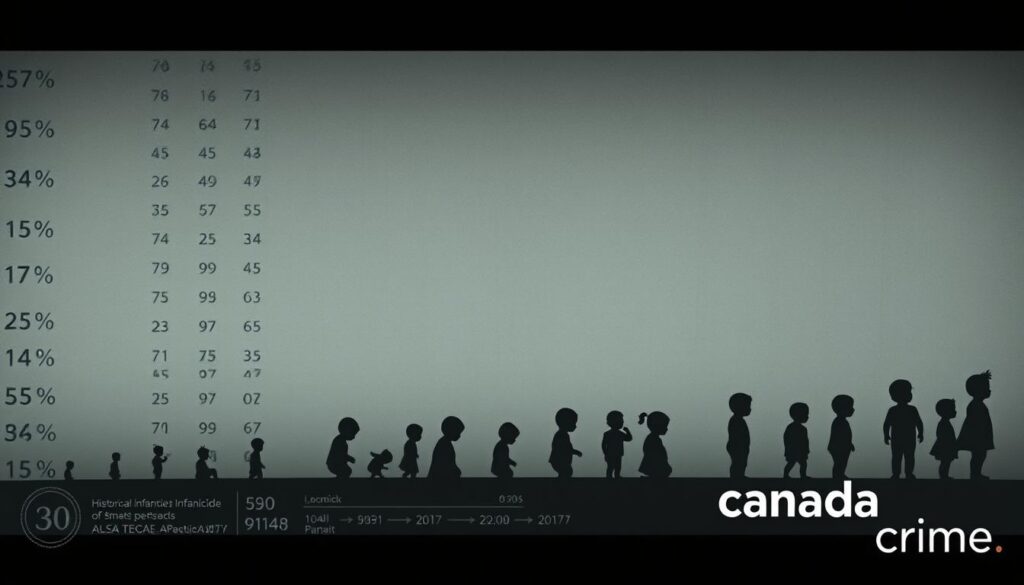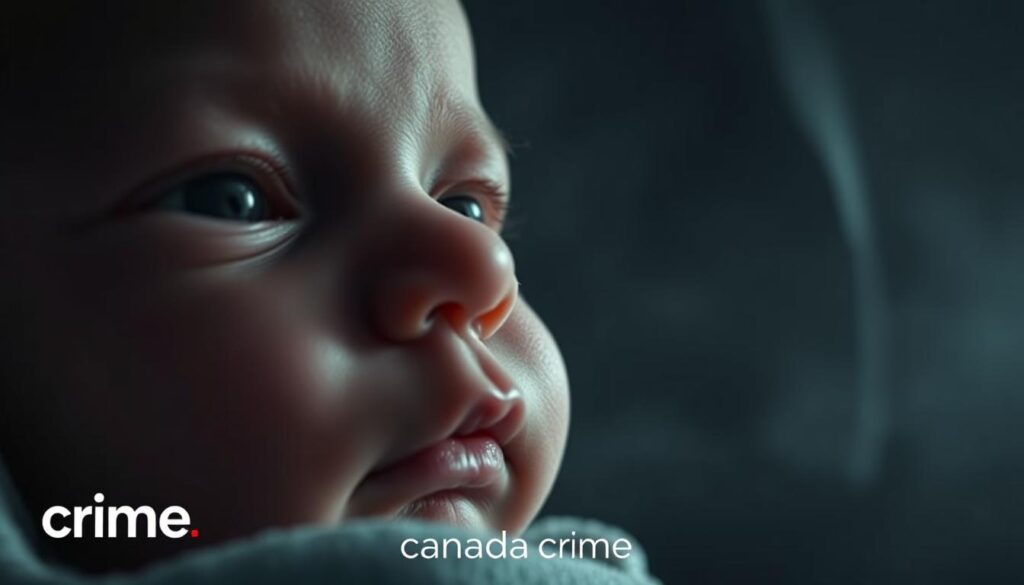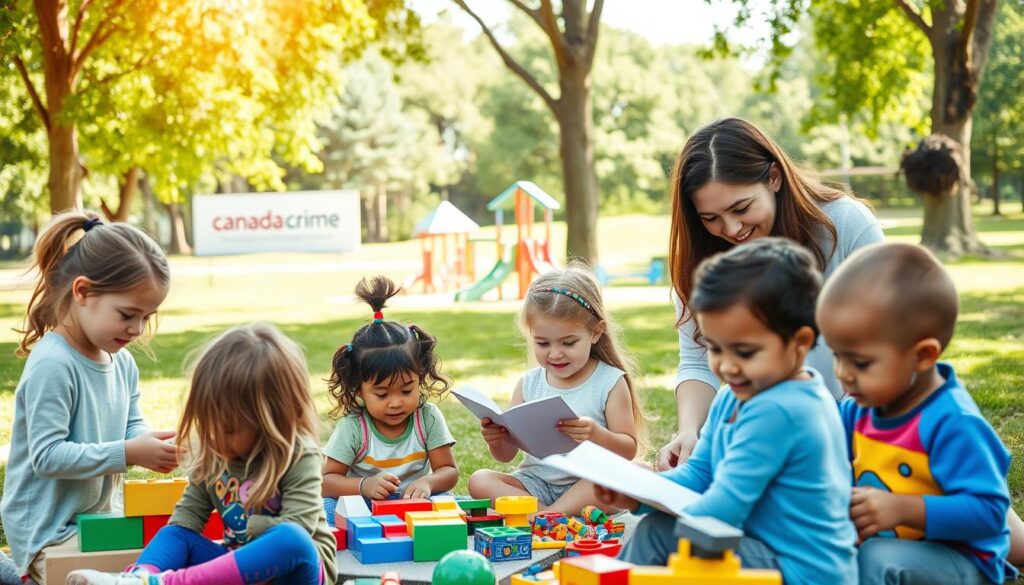Did you know about 25% of child murders in Canada involve babies under one year? This fact shows how important it is to tackle infanticide. As a parent or caregiver, it’s critical to know the risks and how to prevent harm to kids.
This article will cover key tips to stop infanticide, especially in Canada. We emphasize on learning and getting help. This way, we can greatly improve child safety and avoid these sad situations.
Understanding Infanticide: Definition and Legal Aspects
To understand infanticide well, we must look into its definition and Canada’s laws. It’s a complex issue that touches on mental health and legal areas.
What is Infanticide?
The term infanticide refers to a parent or guardian killing a baby. This act is usually linked to the parent’s mental health after giving birth. Knowing these psychological factors helps fight the issue.
Legal Definitions in Canada
In Canada, the Canada crime code explains how to deal with infanticide. It sees it as a crime if a new mother, not in her right mind because of giving birth, kills her baby. The law understands that childbirth can deeply affect mental health.
This understanding helps treat mothers fairly while keeping justice in mind. It shows compassion and helps create better policies and ways to prevent infanticide.
Historical Context and Statistics
To really understand infanticide’s history, we have to look closely at the data over time. Studying past infanticide data helps us see how trends have changed. It also shows if steps taken by countries to stop it are working. To understand the situation today, knowing the historical context that affects current policies and statistics is key.

Prevalence of Infanticide in Canada
Canada shows unique trends in infanticide because of its special culture and society. In recent years, the infanticide rates have gone up and down. This is linked to better healthcare and mental health support. Looking at Canada’s infanticide data over time, we notice a fall in cases. But, there are still times when the numbers jump, showing we need to focus our efforts more.
Global Comparison
When we look at infanticide rates worldwide, it’s clear that many factors matter. Things like cultural beliefs, laws, and how easy it is to get mental health care affect these rates. Some countries see higher numbers because they face big economic problems or lack support systems. On the other hand, places with strong healthcare and support often have fewer cases. Studying these global trends helps us fully understand the issue. It shows that each country needs its own plan to stop this terrible act.
Risk Factors for Infanticide
Understanding why infanticide happens helps in stopping violence against kids. Characteristics of mothers and babies play a role in these sad events.
Maternal Characteristics
Some mother-related traits increase infanticide risks. These include being a young mother, mental health challenges, and feeling alone. For instance:
- Young Age: Young moms might not have the know-how or means to take care of a baby well.
- Mental Health Issues: Problems like severe depression after childbirth can make it hard for a mom to care safely for her baby.
- Social Isolation: When a mom doesn’t have a strong support network, she might lack the emotional and practical help she needs.
Infant Characteristics
Baby-related factors also matter. Important traits include:
- Low Birth Weight: Babies born too small may need more care, which can be tough on parents.
- Gender: In some places, preferring boys over girls can endanger baby girls.
The table below shows how these risk factors compare:
| Key Factors | Maternal Characteristics | Infant Characteristics |
|---|---|---|
| Common Age Range | Young mothers (under 20) | – |
| Mental Health | Depression, psychosis | – |
| Social Isolation | Limited support networks | – |
| Birth Weight | – | Low birth weight |
| Gender | – | Female (in certain cultures) |

Psychosocial Factors Contributing to Infanticide
Infanticide is linked to a mix of societal, psychological, and economic pressures. Financial troubles greatly increase feelings of despair and desperation in vulnerable parents.
Another key issue is the lack of help from others. Parents without family or community support feel alone and stressed. This can worsen mental health issues, increasing the risk of infanticide.

Mental health is crucial in infanticide cases. Disorders like depression and anxiety affect how people think and handle emotions. If these aren’t treated, it can end tragically.
| Psychosocial Contributor | Impact on Infanticide Risk |
|---|---|
| Financial Instability | Increases stress, hopelessness, and desperation |
| Lack of Social Support | Leads to isolation and overwhelming feelings |
| Mental Health Challenges | Affects judgment and emotional regulation |
We must tackle these issues with strong support services and help. By dealing with financial problems, building support networks, and improving access to mental health care, we can lower infanticide risks and help both parents and babies.
Impact of Postpartum Mental Health on Infant Safety
The mental health of new moms greatly affects how safe their babies are. Issues like postpartum depression and psychosis impact mothers worldwide. It’s important we understand and talk about them more.

Understanding Postpartum Depression and Psychosis
Postpartum depression hits new moms hard, making them feel extremely sad, disconnected from their baby, and full of guilt. Postpartum psychosis, though less common, is more intense with symptoms like seeing things that aren’t there and feeling very confused. Both can make caring for a baby really hard, risking the baby’s safety.
Statistics and Realities
About 10-20% of new moms deal with postpartum depression. Postpartum psychosis is rarer, affecting 1-2 out of 1000 women. These stats show how critical it is to spot and treat these issues early. If not, the results can be harmful for both the mom and her baby.
Here’s a detailed look at postpartum depression vs. psychosis and how they can impact a baby’s safety:
| Condition | Prevalence | Symptoms | Potential Impact on Infant Safety |
|---|---|---|---|
| Postpartum Depression | 10-20% | Sadness, lack of interest, guilt | Neglect, impaired bonding |
| Postpartum Psychosis | 1-2 per 1000 women | Hallucinations, delusions, agitation | Risk of harm, severe neglect |
By learning about postpartum depression and psychosis, we can better help moms and keep babies safe.
Tips to Prevent Infanticide
Stopping infanticide needs awareness, laws, and support networks. By using certain strategies, we can lower risks. We can also help those who need it.
Safe Haven Laws and their Importance

Safe Haven Laws let parents give up their newborns without giving their names. These laws help stop infanticide by offering a secure choice. Making sure people know and understand these laws can save lives.
Promoting Awareness and Education
Teaching people how to prevent infanticide is key. Campaigns and programs in the community raise awareness. They also show how to get help. Teaching about infanticide prevention makes sure parents know about the laws and help they can get.
Supporting At-Risk Mothers
Helping mothers who might be at risk is very important in stopping infanticide. Help includes counseling, money help, and childcare. Giving these resources can help mothers feel stronger. This can make them less likely to take desperate steps. Help can come from the government and charities.
- Ask for better Safe Haven Laws.
- Better education on stopping infanticide with public programs.
- Give full support for mothers who might be at risk.
Effective Child Protection Strategies
Making sure kids are safe is key to their well-being and helps prevent very bad things like harm to them. Bringing different groups together with a wide-reaching plan makes keeping kids safe even stronger.

Community Involvement
Community involvement in child safety is super important for keeping the young ones protected. When everyone is alert and supportive, it becomes easier to spot dangers early and step in quickly. Getting people in the neighborhood, local groups, and families involved in safety talks and training makes the whole community more aware.
Multidisciplinary Approaches
Using a multidisciplinary prevention strategy makes our fight against threats to children strong and all-encompassing. This method gets doctors, social helpers, teachers, and police to join forces. They each bring their special skills to the table. By talking often and working together, they form a protective circle around kids that looks at safety from every angle.
Combining child protection strategies with help from the community and experts from different fields is crucial. It creates a safer world for our kids. By pulling together the know-how and efforts of various people, we’re better equipped to stop bad things before they happen and keep our kids safe.
Early Childhood Intervention Programs
Early childhood intervention programs are key in protecting infants and reducing infanticide risks. These programs start from the prenatal stage, working to prevent possible dangers early on. The importance of prenatal care is huge because it prepares for a safe pregnancy and catches any issues early.

Importance of Prenatal Care
Prenatal care is crucial for early childhood intervention success. It includes doctor visits, advice on nutrition, and tips for a healthy pregnancy. By focusing on the health of expectant mothers and their babies, it spots risks early. This helps prevent health problems before they become serious.
Support Services for New Mothers
New mothers need support right after birth and later. They get help through checkups, mental health support, breastfeeding tips, and parenting advice. These programs give new moms the tools and help they need. This reduces the risks linked to infanticide, making it safer for moms and babies.
Role of Healthcare Providers in Preventing Infanticide
Healthcare workers play a key part in stopping infanticide. They do this by spotting and tackling possible risks early. They make sure to screen carefully and offer support during regular care. This way, they boost the odds of catching and helping early, protecting moms and babies.
Screening and Assessment
Healthcare providers must carefully check for any signs that might lead to infanticide. This means looking into a mom’s mental health, watching for postpartum depression, and noticing stress. Finding these signs early through regular visits and mental checks can save lives.

Providing Resources and Referrals
It’s very important for healthcare workers to help at-risk families get the support they need. They should identify those in need and guide them to the right help. This help might be mental health care, social services, or support groups in the community. Making sure families can reach these aids is key in lessening the danger of infanticide.
Legal Measures and Policies
In Canada, laws about infanticide focus on stopping it before it happens and punishing those responsible. The way the criminal code regarding infanticide works shows the progress made in achieving justice and preventing crimes.
Criminal Code and Punishments
The Criminal Code of Canada includes laws on murder, attempted murder, and infanticide. It has specific sections, 229-231 and 235, that lay out the consequences for these crimes. Infanticide has a different kind of punishment from murder, recognizing the mental health issues that may affect the person responsible.
The code also has parts that protect kids, like section 218 about leaving a child alone and sections 151-153 on crimes against minors. These laws aim to stop harm before it happens and punish wrongdoers, providing a safe framework for everyone.

Legislative Solutions
Creating laws has been key to preventing infanticide. This includes laws against family violence, like the Protection Against Family Violence Act in Alberta and the Domestic Violence and Stalking Act in Manitoba. These laws let the police act quickly to keep families safe.
Considering family violence as a big issue during sentencing shows how serious these crimes are. Laws aimed at protecting kids, like the Child, Youth and Family Enhancement Act in Alberta and the Child, Family and Community Service Act in British Columbia, focus on keeping children safe.
Together, these efforts form a strong strategy against infanticide. They aim to create a culture where the youngest and most at-risk are safely protected.
Promoting Child Welfare and Safety
Keeping children safe is a duty that involves everyone in the community. Teaching people about child safety and starting health projects can lower risks like infanticide. This effort requires everyone’s contribution to make a big difference.
Community Education Programs
Teaching the community about child safety is crucial. These programs share tips on spotting danger and how to shield kids. Workshops, online materials, and seminars help everyone pitch in. Together, we can make a safe space for our kids.
Public Health Campaigns
Public health campaigns are key in keeping kids safe. They tackle reasons children are at risk, focusing on mental health and supporting parents. These efforts offer essential services to keep kids in safe homes. Investing in these campaigns leads to lasting safety and happiness for children.
Resources and Support Systems
When dealing with the issue of preventing infanticide, it’s essential to be aware of many helpful resources. There are various groups ready to help those who are in danger. They offer quick help through helplines and emergency hotlines, making sure help is always ready.
Hotlines and Helplines
Emergency hotlines are key in fighting infanticide. The Canadian Crisis Services hotline, for instance, is open 24/7. It provides immediate counseling and help. Professionals there are trained to give the support and advice needed.
Also, the Kids Help Phone is an important service for children and mothers in crisis. These helplines are vital in stopping possible infanticidal actions. They do this by giving quick support and pointing people to specialized services.
Local Support Groups
Joining local support groups offers long-term help and a feeling of belonging. These groups bring together people facing similar issues. In Canada, many local groups focus on giving emotional and practical help to mothers at risk.
Postpartum Support International has chapters that help mothers with postpartum mental health issues. These local groups build a supportive network. This network can greatly reduce the dangers related to infanticide.
Knowing about these resources, like emergency hotlines and local groups, is crucial. They can truly help save lives by protecting those who are vulnerable.
Conclusion
To tackle the sad case of infanticide, we need a plan that covers a lot of ground. We’ve seen how important it is to mix law, support, and community efforts. Knowing the signs, like mental health risks after giving birth and social pressures, helps spot which mothers and babies need help.
Keeping kids safe should be everyone’s goal in the community. Doctors and nurses should be on the lookout and refer families to resources. We also need strong teamwork to protect children. Laws that provide safe places for babies and early help programs are key to protecting them.
The laws and public rules should back up these steps to keep at-risk individuals from reaching a breaking point. Education, support lines, and local groups, along with strict legal monitoring, can make our communities safer for kids. Everyone’s effort, including people, doctors, lawmakers, and community groups, is critical. Together, we can work towards stopping infanticide and securing the well-being of all kids.

